We all belong to the same human family.
My Y-DNA
This is the story of my Biggins ancestry from Nigeria in Africa to Southwest Asia and Southeast Asia. Then the story goes back west to Central Asia, Western Asia, and Southwest Asia, and Western Europe. From there, the story goes on to England and Ulster. Then Ontario, Canada, and the United States.
Y-DNA can do several things for people interested in ancestry:
- Family Tree Y-DNA can sometimes help extend a family tree back a few generations. This has not happened for me yet.
- Surname Origin Y-DNA can sometimes identify when a surname was first adopted. I am part of a group of 12 men with the name of Beggan, or a variation thereof, who share a unique Y-DNA mutation named R-BY3164. It is estimated to have occurred in a man born around 1350 or 1400 AD in Ulster.
- Allied Surnames These 12 Biggins/Beggan testers share a mutation named R-FT14481 with men named McDonald, McAuley. McGuire, and Larkin. This mutation occurred in a man born around 750 AD.
- Clan In some cases, Y-DNA can connect us with a clan that our ancestors came from in the last one or two thousand years. This has happened for me. I share the Y-DNA (mutation R-Z3008) of men with a combination of surnames that ancient pedigrees trace back to The Three Collas, warriors from England who went to Ulster in Ireland to fight against the Ulaid in the 4th or 5th century.
- Ancient Peoples Y-DNA can connect us with an ancient people or language groups. My R-Z3008 is Celtic. It descends from R-P312, a mutation that occurred in a man born around 2900 BC in Southern Germany and populated France, Spain, Scotland, Wales, Ireland, and Galatia.
- Ancient Common Ancestor If you test the Y-DNA of several ancestors, you can see their ancient common ancestor. I have tested the Y-DNA of five great great grandfathers. Their common ancestor is R-L151, ancestor of Saxons and Celts, who was born in 3050 BC in Ukraine
- Around the World Y-DNA tells us our male ancestry back to "Adam." It shows us where we branch off from the many groups that populate different parts of the World: Siberians, Japanese, Australian Aborigines, Romani, Indian, Israeli, Chinese, Korean, Native Americans, Vikings, etc.
How I Got Started
In 2008, Daniela Moneta started a Biggins Y-DNA project. Daniela, a professional genealogist, started the project as part of her efforts to learn more about her ancestor Eleanor Biggins who was born in 1798 in Middlesex, England. Daniela found my Biggins/Beggan Irish Roots on the Internet and asked me to have my Y-DNA tested. I was skeptical because of the cost and doubtful that I would learn anything, but my wife Marilyn encouraged me to do it. I learned a lot, but I am not sure that Daniela did.
In 2009, I received an email from Josiah McGuire. He said that surnames we have matches with are said to descend from "Colla da Chrioch" as stated in the Irish Pedigrees by O'Hart. He started the Clan Colla Null 425 Project at FTDNA to attract Clan Colla descendants. I agreed to be a co-administrator and was the first one to join the new Clan Colla project. I started a Web page called DNA of the Three Collas. We then found two geneticists with our Clan Colla DNA and asked them to join us in administering the Clan Colla project: Patrick McMahon who had studied genetics at Trinity College Dublin and the late Tom Roderick who was on the Emeritus Staff at The Jackson Laboratory in Bar Harbor, Maine, and was a member of the Human Genome Project.
About Y-DNA
Shared mutations on the Y chromosome of different individuals indicate that they share a common male ancestor at some point in their lineage, allowing researchers to trace paternal ancestry through the presence of these shared mutations and group individuals into Y-DNA haplogroups. Shared Y-DNA mutations are only passed through the male line. These mutations are passed directly from father to son, allowing for tracing of paternal ancestry. When multiple individuals share a specific mutation on their Y chromosome, they are classified within the same group, representing a distinct branch on the evolutionary tree of the Y chromosome. Mutations accumulate over time. As generations pass, new mutations can occur on the Y chromosome, leading to the development of different sub-groups within a larger group. By comparing the pattern of shared mutations between individuals, geneticists can estimate how closely related they are through their paternal line and when they might have shared a common ancestor.
This story addresses the deep ancestry of Peter Biggins including the use of Y-DNA mutations, tested by Family Tree DNA.
- Y-DNA. Y-DNA is passed down from father to son, much like surnames. By testing a living male, we can learn about the deep ancestry of his paternal line. This testing also applies to his sons and their sons, his brothers and their sons, and his paternal male cousins
DNA is Deoxyribonucleic acid. It is a chemical consisting of a sequence of hundreds of millions of nucleotides found in the nuclei of cells. It contains the genetic information about an individual. In 1953, they discovered it was shaped like a double-stranded helix. In 2003, they finished first sequencing of the human genome.
- Mutation. A Y-DNA mutation is called a SNP (single nucleotide polymorphism). It happens when a single nucleotide (A, T, G, or C) in the genome sequence is altered. For me, at position 8556635, an A has mutated to a C. If someone else has this mutation, there is a good chance we share a common Biggins/Beggan ancestor. A haplogroup is a SNP shared by two or more testers. Family Tree DNA discovered in 2015 that I shared the A>C mutation at position 8556635 with another person named Bigham and named the mutation BY3164. Haplogroups allow the creation of a tree with branches, like a family tree in genealogy. Major branches are represented by the letters A through T.
See Human Y-chromosome DNA haplogroup.
Migration Route of Y-DNA
Migration Route of Biggins Y-DNA

The Estimated Migration Route of My Y from A-PR2921 in Africa in 232000 BC to R-DF13 in Northern England in 2500 BC. Source: Discover More. |
Connections with People Around the World
Y-DNA tells us our Biggins male ancestry back to "Adam." It also shows us where we branch off from the many groups that populate different parts of the World. For example:
- Africans (Y-Adam): A-PR2921, 232000 BC, Nigeria, step 1
- Southern Europeans, and East Asians: CT-M168, 64000 BC, Western Ethiopia, step 6
- Native Americans, Siberians, Japanese, and Australian Aborigines: CF-P143, 63000 BC, Northern Ethiopia, step 7
- Romani and Khmers: GHIJK-F1329, 46000 BC, Southern Iran, step 9
- South Asians on the Indian subcontinent: HIJK-PF3494, 46000 BC, Southern Iran, step 10
- Arabs and Israelites: IJK-L15, 45000 BC, Southern Iran, step 11
- Chinese, Koreans, and other Southeast Asians: K-M526, 43000 BC, Bangladesh, step 13
- Eskimos, Navajos, Apaches, Aztecs, Incas: P-P226, 30000 BC, Eastern Mongolia, step 19
- Vikings in Scandinavia: R-M173, 20000 BC, Eastern Kazakhstan, step 21
- Saxons and Celts: R-L151, 3050 BC, Ukraine, step 31
Biggins Deep Ancestry
| Year |
Place |
Mutaion That Was Born |
Testers Who Have the Mutation |
About the Mutation and Its Branches |
| 232000 BC |
Southeastern Nigeria |
A-PR2921 |
686,677 |
Step 1. "Adam." Haplogroup A's oldest sub-clades are exclusively found in Central-Northwest Africa, where it, and consequently Y-chromosomal Adam, is believed to have originated. The clade has also been observed at notable frequencies in certain populations in Ethiopia, as well as some Pygmy groups in Central Africa. A-PR2921 branches to
- A-L1087 in Cameroon
- A-L1090 ↓
|
| 152000 BC |
Eastern Nigeria |
A-L1090 |
686,665 |
Step 2. Branches to
- A-V148 in Cameroon
- A-V168 ↓
|
| 126000 BC |
Northeastern Nigeria |
A-V168 |
686,573 |
Step 3. Branches to
- A-M31 in Mali and Algeria
- A-V221 ↓
|
| 121000 BC |
Sudan |
A-V221 |
686,294 |
Step 4. Branches to
- A-L419 in South Sudan and Ethiopia and beyond
- BT-M42 ↓
|
| 86000 BC |
Sudan |
BT-M42 |
685,529 |
Step 5. Ancestral to all non-African haplogroups. Branches to
- B-M181 in Central African Republic and beyond
- CT-M168 ↓
|
| 64000 BC |
Western Ethiopia |
CT-M168 |
684,110 |
Step 6. Branches to
- DE-M145 in Southeast Sudan. Branches to
- E-M96, common in Africa, and to a lesser extent the Middle East and southern Europe. Napoleon Bonaparte descends from this mutation
- D-F974, mainly found in East Asia, parts of Central Asia, and the Andaman Islands, but also sporadically in West Africa and West Asia
- CF-P143 ↓
|
| 63000 BC |
Northern Ethiopia |
CF-P143 |
623,868 |
Step 7. Branches to
- C-M216 in Southeastern Iran, then Southern and Eastern Europe, Native America, Siberia, Japan, Australia Aborigine. See: CF-P143 Migration map.
- F-M89 ↓
|
| 46000 BC |
Southeastern Iran |
F-M89 |
619,667 |
Step 8. Branches to
- F-F15527 in Northern Vietnam
- GHIJK-F1329 ↓
|
| 46000 BC |
Southern Iran |
GHIJK-F1329 |
619,305 |
Step 9. Branches to
- G-M201, found in the Caucasus region, between the Black Sea and the Caspian Sea. DNA of Ötzi, also called the Iceman, who lived between 3400 and 3100 BC
- G-M201, found in the Romani people and the Khmer people
- HIJK-PF3494 ↓
|
| 46000 BC |
Southern Iran |
HIJK-PF3494 |
594,974 |
Step 10. Branches to
- H-L901, also known as the "Indian marker," mostly restricted to South Asian populations of the Indian subcontinent. See: HIJK-PF3494 Migration map.
- IJK-L15 ↓
|
| 45000 BC |
Southern Iran |
IJK-L15 |
592,553 |
Step 11. Branches to
- IJ-P124
- I haplogroup, represents up to one-fifth of the male population of Europe, being the continent's second major Y-DNA haplogroup behind haplogroup R. Some think of the Normans as being I-M253.
Our son-in-law Roger Byrne has I haplogroup DNA: I-M223 (14000 BC, Southern Germany), M284, L126, Y4751, BY3619, Y63570, BY75184, and FTA14037 (1750 AD). Roger's great great grandfather, Patrick H. Byrne, was born in Ireland in 1835. He shares FTA14037 with Donald Austin Byrne (1934-2017), whose oldest known Byrne ancestor is Austin Thomas Byrne (1859-1934), born in Dublin. He also matches closely with three testers named McGivern, which is associated with Rostrevor, County Down. Byrne may be a form of McGivern. I-M284 is one of the most ancient Y lineages in Scotland, but it is also found in Ireland
- J-M267 (17000 BC, Western Turkey), includes a large portion of contemporary Jewish Kohanim. According to the Bible, the ancestor of the Kohanim was Aaron, the brother of Moses
- K-M9 ↓
|
| 43000 BC |
Western Pakistan |
K-M9 |
400,379 |
Step 12. Branches to
- LT-L298 in Eastern Pakistan and beyond
- K-M526 ↓
|
| 43000 BC |
Bangladesh |
K-M526 |
389,505 |
Step 13. Branches to
|
| 43000 BC |
Bangladesh |
K-YSC0000186 |
358,471 |
Step 14. Branches to
- MS-Z31109 in Southern Burma.
- P-PF5850 ↓
|
| 43000 BC |
Northeastern India |
P-PF5850 |
358,184 |
Step 15. Branches to
- P-FTC1 in Northeastern India
- P-P295 ↓
|
| 42000 BC |
Northeastern India |
P-P295 |
358,178 |
Step 16. Branches to
- P-F20149 in Northern Vietnam
- P-FT292000 in Northeastern India
- P-M45 ↓
|
| 34000 BC |
Northeastern India |
P-M45 |
358,118 |
Step 17. Branches to P1, then
- P-FT344716 in Northeastern India
- P-P284 ↓
|
| 34000 BC |
Northeastern India |
P-P284 |
358,116 |
Step 18. Branches to
- P-FT344715 in Northeastern India
- R-P226 ↓
|
| 30000 BC |
Eastern Mongolia |
P-P226 |
358,115 |
Step 19. Branches to
- Q-M242 in Southern Siberia. It branches to the predominant Y-DNA haplogroup among several peoples of Central Asia and Northern Siberia and Eskimos, Navajo, Apache, and Aztecs. See: P-P226 Migration map.
- R-M207 ↓
|
| 26000 BC |
Southern Siberia |
R-M207 |
347,099 |
Step 20. Originated in North Asia just before the Last Glacial Maximum (26,500-19,000 years ago). This haplogroup has been identified in the remains of a 24,000 year-old boy from the Altai region, in south-central Siberia
Branches to
- R-M479 in Northern Pakistan
- R-M173 ↓
|
| 20000 BC |
Eastern Kazakhstan |
R-M173 |
344,742 |
Step 21. The majority of representatives of haplogroup R are in its branches
- R-M420 in Southern Russia. Viking. Sometimes called R1a. Distributed in a large region in Eurasia, extending from Scandinavia and Central Europe to southern Siberia and South Asia. There is a significant presence in peoples of Scandinavian descent, with highest levels in Norway and Iceland, where between 20 and 30% of men are in R1a1a M17/M198 (6600 BC).
Most of Clan Donald is Viking: Macdonalds of Clanranald, Glengarry, Keppoch, and Sleat. (The remander are Celtic and descend from CVoplla Uais and Somerled: Clan Donald of Leinster amd Clan Donald of Ulster.)
- R-M343 ↓
|
| 17000 BC |
Uzbekistan |
R-M343 |
287,695 |
Step 22. Sometimes called R1b. The point of origin of R1b is thought to lie in Western Eurasia, most likely in Western Asia. It is the most frequently occurring paternal lineage in Western Europe. R1b also reaches high frequencies in the Americas and Australia, due largely to immigration from Western Europe. See Eupedia R1b. Family Tree DNA: R1b M343 Project. Branches to
- R-BY14355 in Uzbekistan
- R-L754 ↓
|
| 17000 BC |
Uzbekistan |
R-L754 |
285,485 |
Step 23. Found in Villabruna 1, who lived circa 12,000 years BC (north east Italy). Villabruna 1 belonged to the Epigravettian culture
Branches to
- R-FTE1 in Uzbekistan
- R-L761 ↓
|
| 15000 BC |
Uzbekistan |
R-L761 |
285,482 |
Step 24. Branches to
- R-PF6323 in Uzbekistan
- R-FTH70 in Uzbekistan
- R-L389 ↓
|
| 15000 BC |
Uzbekistan |
R-L389 |
284,541 |
Step 25. Branches to
- R-BY15377 in Uzbekistan
- R-P297 ↓
|
| 13000 BC |
Uzbekistan |
R-P297 |
284,263 |
Step 26. Branches to
- R-M73 in Uzbekistan
- R-M269 ↓
|
| 4450 BC |
Southwestern Russia |
R-M269 |
283,902 |
Step 27. The most common European haplogroup, greatly increasing in frequency on an east to west gradient. Branches to
- R-PF7562 in Southern Russia
- R-FTG713 in Southern Russia
- R-L23 ↓
|
| 4350 BC |
Southern Russia |
R-L23 |
275,613 |
Step 28. Branches to
- R-Z2103 in Southern Russia
- R-L51 ↓
|
| 4100 BC |
Ukraine |
R-L51 |
267,400 |
Step 29. Branches to
- R-PF7589 in Ukraine
- R-P310 ↓
|
| 3400 BC |
Ukraine |
R-P310 |
265,006 |
Step 30. Branches to
- R-FT377377 in Ukraine
- R-FT186340 in Ukraine
- R-FT123498 in Ukraine
- R-L151 ↓
|
| 3050 BC |
Ukraine |
R-L151 |
264,650 |
Step 31. Ancestor of all five on my family tree whose descendants have been Y-DNA tested:
- Johann Drücke (name originally Börger), b. 1743 in Elspe, Lennestadt, Olpe, Germany<
- Adam Berles (Berlar), b. 1794 in Landenbeck, Eslohe, Hochsauerland, Germany
- Patrick Biggins (Beggan), b. 1807 in Drumgill, County Cavan, Ireland
- Daniel McDonald, b. 1813 in Ireland or Scotland
- Edward Carroll, b. 1835 in Ballyneety, County Limerick, Ireland
Branches to "Saxon" and "Celtic"
- R-U106, "Saxon," in Western Poland. Z381 branches to
- R-Z301. My maternal grandfather William F. Drueke has this DNA: U106, Z301, L48, Z9, Z30, Z2, Z7, CTS10893, A6389, BY3323 (323 BC). My great great great grandfather Johann Drüecke was born in 1743 in Elspe, Westphalia, Germany. Westphalia is part of Old Saxony. Based on my maternal cousin Paul Drueke's Y-DNA test at Family tree DNA. Most of Paul's Y-DNA matches at FTDNA are from England. The Saxons invaded and settled the south and east of England from the early 5th century up to the Norman conquest in 1066.
- R-Z156, Z306, Z304, DF98, S18823, S22069, S8350, Y17443, BY3238. House of Wettin: King George V, Edward VII, George VI
- R-S1194 in Ukraine
- R-A38053 in Ukraine
- R-FTA1 in Ukraine
- R-P312, "Celtic" ↓
|
| 2900 BC |
Southern Germany |
R-P312 |
164,670 |
Step 32. "Celtic." The most common haplogroup across much of Western Europe. See Family Tree DNA: R-P312 Project.
Ancestor of four out of five on my family tree whose descendants have been Y-DNA tested:
- Adam Berles (Berlar), b. 1794 in Landenbeck, Eslohe, Hochsauerland, Germany
- Patrick Biggins (Beggan), b. 1807 in Drumgill, County Cavan, Ireland
- Daniel McDonald, b. 1813 in Ireland or Scotland
- Edward Carroll, b. 1835 in Ballyneety, County Limerick, Ireland
Branches to
- R-DF19
- R-L238
- R-A9063
- R-Y18211
- R-BY25512
- R-Z29913
- R-Z46516, R-ZZ11
- DF27 Gallic & Iberian. My wife Marilyn's father has this DNA: DF27, Y5058/A641, Y5061, BY61861, FT79210 (950 AD). This is based on the Y-DNA of her second cousin, once removed, Michael Patrick Carroll. Her great grandfather Edmond Carroll was born in 1835 in Ballyneety, County, Limerick, Ireland. Michael matches men named Ryan, O'Dwyer, Lee/Leary, Gorman, and Kennedy, as well as Carroll. According to ancient pedigrees, these men descend from Breassal Breac who lived in Leinster around 200 or 100 BC. They settled in the 13th or 14th century in County Tipperary and County Limerick
- U152 Italo-Celtic
- R-Z290 ↓
|
| 2750 BC |
Southern Germany |
R-Z290 |
89,872 |
Step 33. Branches to
- R-BY22760
- R-L21 ↓ Atlantic Celtic
|
| 2650 BC |
Southern England |
R-L21 |
89,829 |
Step 34. Ancestor of three out of five on my family tree whose descendants have been Y-DNA tested:
Named in 2005 by Thomas Krahn in honor of the late Leo Little. Atlantic Celtic. Born at the beginning of the Bronze Age. In their 2011 book The Scots, A Genetic Journey, Alistair Moffat and James F. Wilson say L21 "could be said to be the most emphatic signal of the Celtic language speakers of the British Isles. It is found in England, Wales, Scotland and Ireland and it is almost certainly characteristic of those farming communities who may have spoken early forms of Celtic languages in the centuries around 2,000 BC." Family Tree DNA: L21 Project. Branches to
- R-A5846
- R-S552 ↓ Atlantic Celtic
|
| 2650 BC |
Southern England |
R-S552 |
77,344 |
Step 35. Named by Scotlands DNA. Discovered at FTDNA in 2021. Branches to
- R-F4006
- R-DF63
- R-BY11894
- R-BY24776
- R-BY2994
- R-FT21374
- R-BY65267
- R-DF13 ↓ Atlantic Celtic
|
| 2500 BC |
Northern England |
R-DF13 |
76,094 |
Step 36. Named in 2011 by an anonymous member of the DNA-Forums.org genetic genealogy community. Named S521 by ScotlandsDNA and CTS241 by Chris Tyler-Smith. There are many branches and subbranches of DF13, some of which are:
- R-L513, S5668
- Z16340, FGC9798, FGC9784, FGC9795, FGC9811 Airghialla 2, Manus McGuires. Manus McGuires had once been thought to be part of Clan Colla, but they have different mutations. Joseph A. Donohoe V (1941-2011) called them Airghialla 2 and compared their DNA with Clan Colla, which he called Airghialla 1. See Two McGuire Septs
- A7, Z17623, S5970, S5962/L193 Scottish Borders. Many surnames with this marker are associated geographically with the western "Border Region" of Scotland. A few other surnames have a Highland association.
- R-FGC11134, FGC12055, Z3026, Z16250, A114, CTS4466 South Irish
- R-FGC5494
- R-ZZ10
- Z16423, Z255, L159 Irish Sea. Appears to be associated with the Kings of Leinster and Diarmait Mac Murchada; Irish Gaels belonging to the Laigin. It can be found in the coastal areas of the Irish Sea including the Isle of Man and the Hebrides, as well as Norway, western and southern Scotland, northern and southern England, northwest France, and northern Denmark.
- Z253, L226, FGC5660, Z17669, ZZ31, FGC5628, FGC5623, FGC5659, ZZ34, DC782, Y5610 (1030 AD), Brian Boru. Our son's uncle-in-law has Y5610 DNA. Family genealogist Maureen O'Brien traces their heritage back to Michael O'Brien, who was born in Doneraile in 1815. Doneraile is in County Cork, just south of the border with County Limerick. Maureen's father Leo O'Brien is shares Y5610 (1030 AD) with Conor Myles John O'Brien of Dromoland Castle who traces his ancestry back to Brian Boru. Brian Boru was born circa 940 in what is now County Clare and died in the Battle of Clontarf, north of Dublin, on April 23, 1014. L226 DNA type also is called Dalcassian and Irish Type III. See DC782 Brian Boru DNA and Irish Type III DNA.
- R-Z39589
- L1335 Scottish Cluster
- DF49, Z2980, Z2976, DF23, Z2961, Z2956
- FGC6545 Hy Maine Kelly. Hy Maine and Clan Colla had previously been thought by some to be descended from a common ancestor, but they have different mutations. There are Kellys with Clan Colla DNA, but they are likely from another Kelly pedigree called Clankelly.
- Z2965, M222 Northwest Irish (Niall of the Nine Hostages). My wife Marilyn's great grandfather Daniel McDonald has this DNA: M222, S660, S588, S603, FGC23592 (676 AD), BY18200 (1600 AD). Her great great grandfather, Daniel McDonald was born in 1813 in Ireland or Scotland. Based on my wife Marilyn's third cousin, once removed, Michael McDonnel's Y-DNA test at Family Tree DNA. Michael's FGC23592 DNA is associated with a group called Cenel Moain (S603, FGC23592), a subset of Cenel Eoghain (S660, S588), a subset of Northwest Irish (M222).
Northwest Irish (Niall) and Clan Colla had previously been thought by some to be descended from a common ancestor.
- DF41, S775, R-L745 (1150 AD) High Stewards. This family started out in Scotland when the first of the line, Walter Fitz Alan (1110-1177) was appointed High Steward of Scotland under King David I. His descendants became Hereditary High Stewards of Scotland. The two most important branches of the family are the Scottish Royal Stewarts, represented by descendants of King Robert II of Scotland (grandson of Alexander Stewart); and the Stewarts of Lennox, with some Scottish descendant lines plus the English Royal Stuarts, who descend from Alexander Stewart's younger son, Sir John Stewart of Bonkyl. See Stewart FTDNA Project. In 1664, Charles II, King of England, 1660-1685, ordered creation of the Kings Highway from Boston. Massachusetts, to Charlestown, South Carolina. Peter has lived on this highway in Darien, Connecticut, since 1989
- R-Z39589
- R-BY23434
- R-BY39001
- R-BY192942
- R-BY146002
- R-FTT9
- R-FTA36024
- R-DF21. ↓ About 10% of all L21 men.
|
| 2350 BC |
Northern England |
R-DF21 |
9,605 |
Step 37. Named in 2011 by an anonymous member of the DNA-Forums.org genetic genealogy community. Named S192 by ScotlandsDNA. See Family Tree DNA: DF21 Project. There are four branches from DF21:
- R-Z30233, which includes L1403 Seven Septs of Laois, FGC5780 Cain/Byrne.
Includes Rathlin 1 Man: A December 2015 study by scientists at Queens University Belfast and Trinity College Dublin identified the DF21 mutation in the bones of a man uncovered in a Bronze Age cist to the rear of McCuaig's Bar in Church Bay on Rathlin Island. Church Bay is connected by a 25-minute ferry ride with Ballycastle in the Glens of Antrim. Rathlin Island is 11 miles from the coast of the Mull of Kintyre in Scotland. His bones were carbon-dated back to 2025-1885 BC.
- R-FGC3213, which includes L362 McCarthy, S5456 Galway Bay and S190 Little Scottish Cluster (from which Alex Williamson descends)
- R-S5488, which includes Z16281 Ely Carroll. There were several illustrious descendants in colonial America. Charles Carroll of Carrollton (1737-1832) signed the Declaration of Independence. Daniel Carroll of Duddington (1764-1849) built a home for himself in 1791 which was torn down by Pierre L’Enfant to build the U.S. Capitol. Daniel Carroll I I of Rock Creek (1730-1796) signed both the Articles of Confederation and the Constitution. John Carroll, S.J. (1735-1815) was the first Roman Catholic bishop in the United States and founded Georgetown University and Georgetown Preparatory School. Testers include a descendant of Charles Carroll of Carrollton and a descendant of Daniel Carroll of Duddington.
- R-Z30233
- R-BY178021
- R-FTC6698
- R-FTB41078
- R-Z16267, which is mostly Clan Colla ↓
|
| 2150 BC |
Northern England |
R-Z16267 |
1,588 |
Step 38. There are three branches from Z16267:
- R-PH129/S7858 shared by Ferguson testers from Ireland and Scotland
- R-BY23573 shared by McRory testers from Scotland and Woolley testers
- R-FT206923 shared by Ward testers from England
- R-F24434 ↓
|
| 2150 BC |
Northern England |
R-F24434 |
1,466 |
Step 39. Found by FTDNA in 2019. There are two branches from F24434:
- R-FGC23381 shared by testers named Rudelli from France, Harbour from England, and McDonalds from Scotland
- R-Z3000 shared by Colla descendants and their cousins, by far the larger branch ↓
|
| 100 AD |
England |
R-Z3000 |
1,407 |
Step 40. 2,000 years after F24434
See Family Tree DNA: Clan Colla 425 null project. See
Z3000 The Three Collas
There are four branches from Z3000:
- Z16270 shared by: Carroll 1, Casey, Paden, O'Guin, Larkin 1, Lawler, Roberts, Roderick, Adams, Calkins, Morris, Godwin, Davie, McGuire 2 and Almond testers
- R-SK195 shared by Hones, Conley, and Gee testers
- R-Y328130 shared by Kelly and Dunphy testers
- R-Z29589 shared by: Baty, Owens, Kenny, Wade, Tevlin, and McGuire 4 testers
- R-Z3006 ↓
|
| 300 AD |
England |
R-Z3006 |
852 |
Step 41. There are four branches from Z3006:
- R-BY24277 shared by Brady, Cusick, Carton, Cain, and Troy testers
- R-BY3160 shared by Smith 2, McMahon, McKenna 3, McGhee, and Greenan testers
- R-BY69501 shared by Morrison, Cull, and Finnegan testers
- R-Z3008, about two-thirds of Z3006 ↓
|
| 450 AD |
Colchester or Wales |
R-Z3008 |
807 |
Step 42. Father of The Three Collas
This DNA is shared by testers with ancestral names that match names in ancient pedigrees of men descended from three Colla brothers who lived in the 4th century in a part of northern Ireland called Airghialla or Oriel. In 1998, Donald M. Schlegel, suggested in his article "The Origin of the Three Collas and the Fall of Emain" in the Clogher Record that the Three Collas were Romanized Britons from the Trinovantes, a celtic tribe from Colchester, the oldest recorded Roman town in England. They received military training from the Romans and eventually went to Ireland as mercenaries in the service of the King of Ireland.
|
| Ulster |
Colla Uais, one of The Three Collas, who fought against the Ulaid in the Fermanagh.
Erc, son of Colla Uais
There are two Y-DNA branches of Colla Uais descendants:
- R-F4142 shared by MacDougall and White testers whose ancestors come from Scotland
- R-S953 ↓
|
| 500 AD |
Tirkeeran Barony in Ulster |
R-S953 |
286 |
Step 43. Carthend, son of Erc. Carthend was given land east of the present city of Derry on the east side of the Foyle, the valley of
the River Faughan, today Tirkeeran Barony, County Londonderry, Northern Ireland. See The River Faughan
Seven churches were founded by St. Patrick in Tirkeeran
There are three branches from S953:
- R-Y9053 shared by Østerud and Moen testers whose known ancestors come from Norway
- R-BY2869 shared by Connally testers
- R-ZZ13 ↓
|
| 600 AD |
Ulster |
R-ZZ13 |
82 |
Step 44. Muredach, son of Carthend
Amalgad, son of Muredach
Aed Guaire, son of Amalgad
Colman Muccaid, son of Aed Guaire
Fergus, son of Colman Muccaid.
There are two branches from ZZ13:
- R-BY24138 shared by Boylan and Donohoe testers
- R-FT14481 ↓
|
| 750 AD |
Ulster |
R-FT14481 |
73 |
Step 45. Conal, son of Fergus
Niad, son of Conal
Fergus, son of Niad
There are five branches from FT14481:
- R-BY39827 shared by McAuley and Beeman testers
- R-BY103517 shared by Larkin
- R-A945 shared by McGuire testers
- R-A938 shared by McDonald 1, McDonald 2, King, and Martin testers.
Seven McDonald 1 testers trace their ancestry back to Lt. Brian McDonald (MacDonnell), McDonnell of Antrim, Somerled, and Colla Uais
- R-BY3164 shared by Biggins/Beggan testers ↓
|
| 1350 AD |
Ulster |
R-BY3164 |
7 |
Step 46. Named by FTDNA in 2015 when it was found to be shared by Bigham N86783 and Biggins 127469. It is now considered the DNA of the 12 testers in the Biggins subgroup.
- 7 have done Big Y and were found to have the BY3164 mutation.
- 5 have not done Big Y, but have unique STRs that predict it: 413b=24 and 561=16.
The surnames of the 12 are all derived from beag, the Irish word for little. Surnames were adopted in Ireland for the first time in the 11th and 12th centuries. Historian Peadar Livingstone reported the name Beggan in southern Co. Fermanagh and northern Co. Monaghan. See Biggins/Beggan Irish Roots and Family Tree DNA: Biggins Project. The 12 testers are:
- Biggins 629651. Ancestor James Biggins was born in 1790 in County Monaghan and emigrated to Western Scotland sometime in the 1820s or 1830s, settling first in Renfrewshire, then Galston, Ayrshire, then Lanarkshire
- Little 896940. Ancestor James Little was born in 1798, County Cavan. He emigrated in the 1840s to Derby, Connecticut, worked in the iron mill
- Biggins 146867: Ancestor James Biggins was born in 1822 in County Monaghan and lived across the road from my ancestor Patrick Biggins in Will County, Illinois
- Beaghen N34030. Ancestor Francis Beaghen was born in 1850 in Ireland and emigrated in 1860 to Brooklyn, New York
- Beggan 166169. Ancestor was born in Clones, Ireland, near the Fermanagh/Monaghan border. Tester Gerard died in Carrickmacross, County Monaghan, in 2018.
- Beggan 190653. Ancestor John Beggan was born in County Fermanagh. Tester Adrian grew up in Meath, lives in Dublin
- Biggin 559385. Ancestor Thomas Biggin was born in Castle Carey, Somerset, England, and emigrated to Australia aboard the James T Foord in November 1849
- Bigham 91030. Ancestor emigrated to Fairfield, Pennsylvania, before the Revolutionary War. The Griffiths Survey of 1848-64 shows 99 of 120 Bighams in County Down, Ireland
- Bigham N86783. Ancestor Hugh Bigham was born in 1750 in Ireland and emigrated to Lebanon, Pennsylvania, before the Revolutionary War
- Little 69648. Ancestor Patrick Beggan was born in 1779 in County Cavan. Tester John's great grandfather changed his name from Beggan to Little. John's father James Little was born in 1898 and nicknamed "Jimmy Beggins" as a child. He emigrated to Ayrshire, Scotland. John himself was born and raised in Ayrshire, emigrated to Canada for fourteen years, and then to Perth, Australia
- Little 906555
- Biggins/Beggan 127469 ↓ - me
| | Birth Year |
Place |
Tester's Ancestors with R-BY3164 Mutation |
|---|
| c. 1780 AD |
County Cavan, Ulster, Ireland |
Hugh Beggan. Married Anne Cusack
|
| 1807 AD |
Drumgill, County Cavan, Ireland |
Patrick Beggan, son of Hugh and Ann Cusack Beggan. Married Bridget. Emigrated to Upper Canada (Southern Ontario), then Lockport, Illinois, USA. Moved to Romeoville
|
| 1841 AD |
Lockport, Illinois |
Philip Leslie Biggins, son of Patrick and Bridget Biggins. Married Sarah McNally. Lived to Naperville, Chicago, and Kewanee, Illinois
|
| 1877 AD |
Romeoville, Illinois |
Philip Leslie Biggins, son of Philip Leslie and Sarah McNally Biggins. Moved to Naperville and Chicago, Illinois. Married Emily Foy
|
| 1910 AD |
Chicago, Illinois |
John Alfred Biggins, son of Philip Leslie and Emily Foy Biggins. Married Jane Marie Drueke. Moved to Grand Rapids and Kalamazoo, Michigan; Glendale, Kirkwood, and Webster Groves, Missouri; Lake Bluff and Wilmette, Illinois; Key Colony Beach, Lauderdale-by-the-Sea, Delray Beach, and Pompano Beach, Florida; and Long Beach and Glendora, California
|
| Birth Year |
Place |
Tester with R-BY3164 Mutation |
|---|
| 1939 AD |
Kalamazoo, Michigan |
Peter Alfred Biggins, son of John Alfred an Jane Drueke Biggins. Moved to Glendale, Kirkwood, and Webster Groves, Missouri; Chicago, Lake Bluff, Wilmette, Chicago. Married Marilyn Kathryn Carroll. Moved to Arlington Heights, and Evanston, Illinois; Darien, Connecticut; Birmingham, Michigan; Dallas, Texas; and Darien, Connecticut. Had three sons and two grandsons who inherited R-BY3164. Tested his Y-DNA with FTDNA kit 127469
|
Tester and Family with R-BY3164 Y-DNA
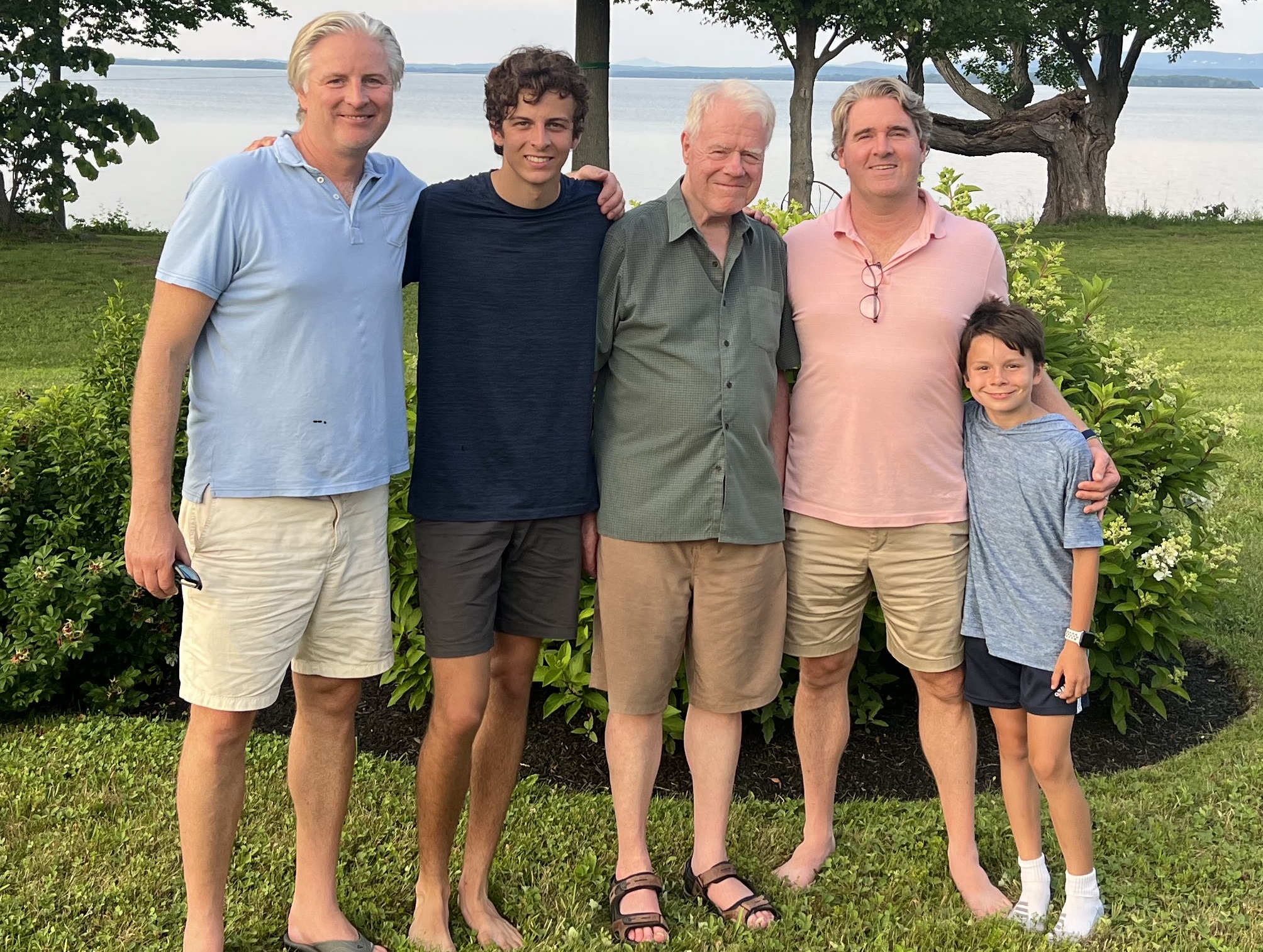
Peter, two sons, and two grandsons with R-BY3164. Lake Champlain, 2023.. |
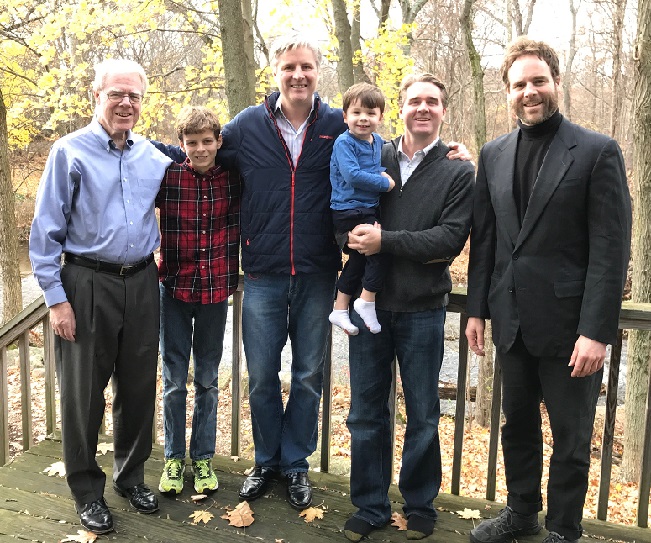
Peter, three sons, and two grandsons with R-BY3164. Five Mile River, Darien, Connecticut, 2016. |
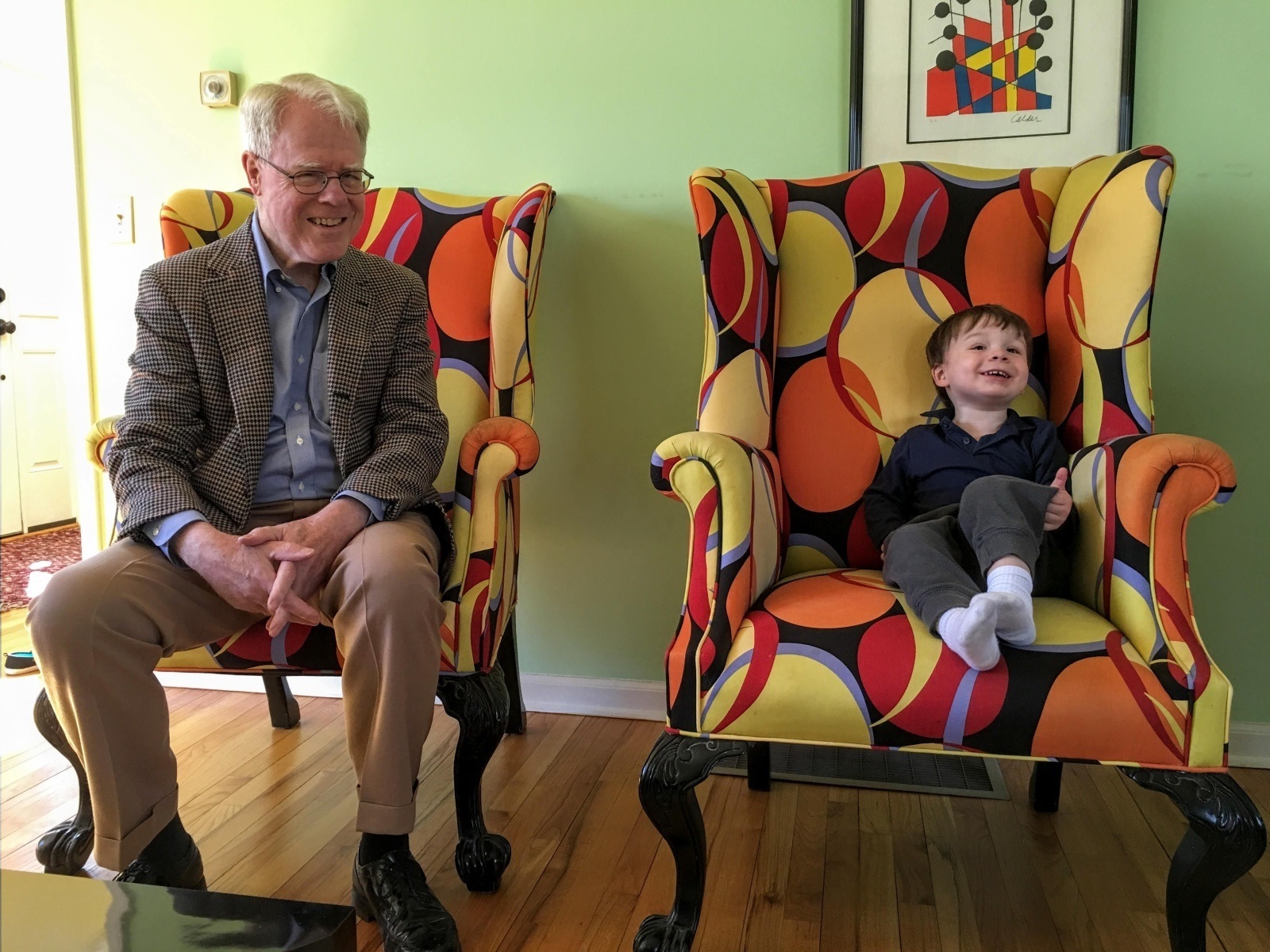
Peter and one grandson with R-BY3164. Darien, Connecticut, 2015. |
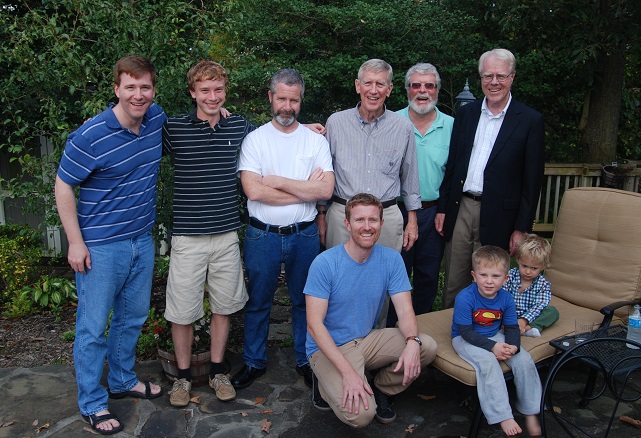
Peter, two brothers, three nephews, and three grandnephews with R-BY3164. Mill River, Lusby, Maryland, 2014. |
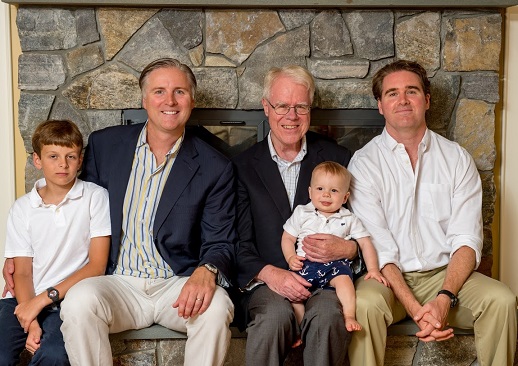
Peter, two sons, and two grandsons with R-BY3164. Lake Champlain, 2014.. |
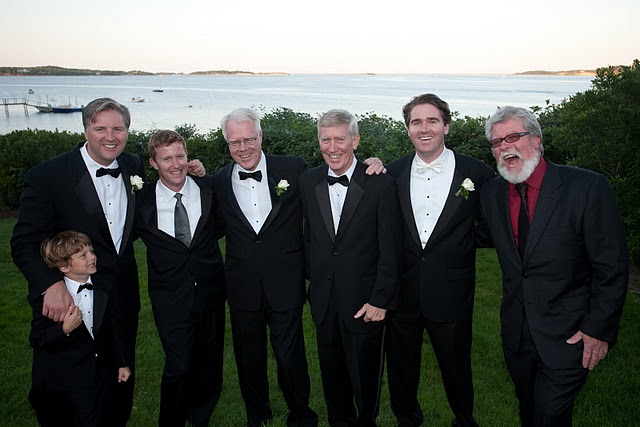
Peter, two brothers, two sons, one grandson, and one nephew with R-BY3164. Cape Cod, 2010. |
|

